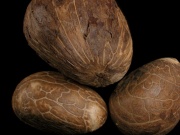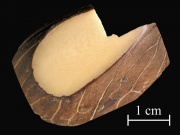Difference between revisions of "Vegetable ivory"
Jump to navigation
Jump to search
(username removed) |
|||
| (3 intermediate revisions by 2 users not shown) | |||
| Line 1: | Line 1: | ||
[[File:tagua nut group1.jpg|thumb|Tagua nuts]] | [[File:tagua nut group1.jpg|thumb|Tagua nuts]] | ||
== Description == | == Description == | ||
| + | [[File:tagua nut piece.jpg|thumb|Tagua nut piece]] | ||
| + | The hard, cream-colored seed of the any of several palm trees. Vegetable ivory resembles true ivory in appearance and hardness, but it has a fibrous microscopic structure. Ivory nuts were used for small carved items, buttons, dice, knife handles, cane heads, and Japanese netsuke. They accept dyes readily and can be polished to a glossy luster. Some of the vegetable ivory palms are: | ||
| − | + | * [[ivory%20nut|ivory nut]] - ''Phytelephas macrocarpa'', found in Colombia and Ecuador | |
| + | * [[doum%20palm|doum palm]] nuts - ''Hyphaene thebaica'', found in Africa | ||
| + | * [[tagua%20nut|tagua palm]] nuts - ''Phytelephas euqatorialis'', found in South America | ||
| + | * apple nuts - ''Metroxylon amicarum'', found in the South Pacific | ||
| − | |||
| − | |||
| − | |||
| − | |||
| − | |||
| − | |||
| − | |||
| − | |||
| − | |||
== Synonyms and Related Terms == | == Synonyms and Related Terms == | ||
ivory nut; doom palm nut; gingerbread palm nut; apple nut; tagua nut; dom nut | ivory nut; doom palm nut; gingerbread palm nut; apple nut; tagua nut; dom nut | ||
| + | ==Physical and Chemical Properties== | ||
| − | == | + | * Color = white but may be dyed any color |
| + | * May be dyed any color, but dyeing may show grain or may not penetrate deeple | ||
| + | * Birefringence = none | ||
| + | * Pleochroism = none | ||
| + | * Fluorescence = variable | ||
| + | * Inclusions = parallel torpedo-shape cells that appear round in cross-section | ||
| − | + | {| class="wikitable" | |
| + | |- | ||
| + | ! scope="row"| Mohs Hardness | ||
| + | | 2.5 | ||
| + | |- | ||
| + | ! scope="row"| Density | ||
| + | | 1.38 - 1.42 g/ml | ||
| + | |- | ||
| + | ! scope="row"| Refractive index | ||
| + | | 1.54 | ||
| + | |} | ||
| − | == | + | ==Resources and Citations== |
| + | * J.Thornton,"The Structure of Ivory and Ivory Substitutes", AIC Preprints, Philadelphia, 1981, p.173-181. | ||
| + | * Gem Identification Lab Manual, Gemological Institute of America, 2016. | ||
* G.S.Brady, ''Materials Handbook'', McGraw-Hill Book Co., New York, 1971 Comment: p. 424 | * G.S.Brady, ''Materials Handbook'', McGraw-Hill Book Co., New York, 1971 Comment: p. 424 | ||
| − | + | * Wikipedia: [https://en.wikipedia.org/wiki/Vegetable_ivory Vegetable Ivory] Accessed Dec 2022 | |
* Hermann Kuhn, ''Conservation and Restoration of Works of Art and Antiquities'', Butterworths, London, 1986 | * Hermann Kuhn, ''Conservation and Restoration of Works of Art and Antiquities'', Butterworths, London, 1986 | ||
| − | |||
* Random House, ''Webster's Encyclopedic Unabridged Dictionary of the English Language'', Grammercy Book, New York, 1997 | * Random House, ''Webster's Encyclopedic Unabridged Dictionary of the English Language'', Grammercy Book, New York, 1997 | ||
| − | |||
* ''The American Heritage Dictionary'' or ''Encarta'', via Microsoft Bookshelf 98, Microsoft Corp., 1998 | * ''The American Heritage Dictionary'' or ''Encarta'', via Microsoft Bookshelf 98, Microsoft Corp., 1998 | ||
Latest revision as of 11:49, 5 January 2023
Description
The hard, cream-colored seed of the any of several palm trees. Vegetable ivory resembles true ivory in appearance and hardness, but it has a fibrous microscopic structure. Ivory nuts were used for small carved items, buttons, dice, knife handles, cane heads, and Japanese netsuke. They accept dyes readily and can be polished to a glossy luster. Some of the vegetable ivory palms are:
- Ivory nut - Phytelephas macrocarpa, found in Colombia and Ecuador
- Doum palm nuts - Hyphaene thebaica, found in Africa
- tagua palm nuts - Phytelephas euqatorialis, found in South America
- apple nuts - Metroxylon amicarum, found in the South Pacific
Synonyms and Related Terms
ivory nut; doom palm nut; gingerbread palm nut; apple nut; tagua nut; dom nut
Physical and Chemical Properties
- Color = white but may be dyed any color
- May be dyed any color, but dyeing may show grain or may not penetrate deeple
- Birefringence = none
- Pleochroism = none
- Fluorescence = variable
- Inclusions = parallel torpedo-shape cells that appear round in cross-section
| Mohs Hardness | 2.5 |
|---|---|
| Density | 1.38 - 1.42 g/ml |
| Refractive index | 1.54 |
Resources and Citations
- J.Thornton,"The Structure of Ivory and Ivory Substitutes", AIC Preprints, Philadelphia, 1981, p.173-181.
- Gem Identification Lab Manual, Gemological Institute of America, 2016.
- G.S.Brady, Materials Handbook, McGraw-Hill Book Co., New York, 1971 Comment: p. 424
- Wikipedia: Vegetable Ivory Accessed Dec 2022
- Hermann Kuhn, Conservation and Restoration of Works of Art and Antiquities, Butterworths, London, 1986
- Random House, Webster's Encyclopedic Unabridged Dictionary of the English Language, Grammercy Book, New York, 1997
- The American Heritage Dictionary or Encarta, via Microsoft Bookshelf 98, Microsoft Corp., 1998

